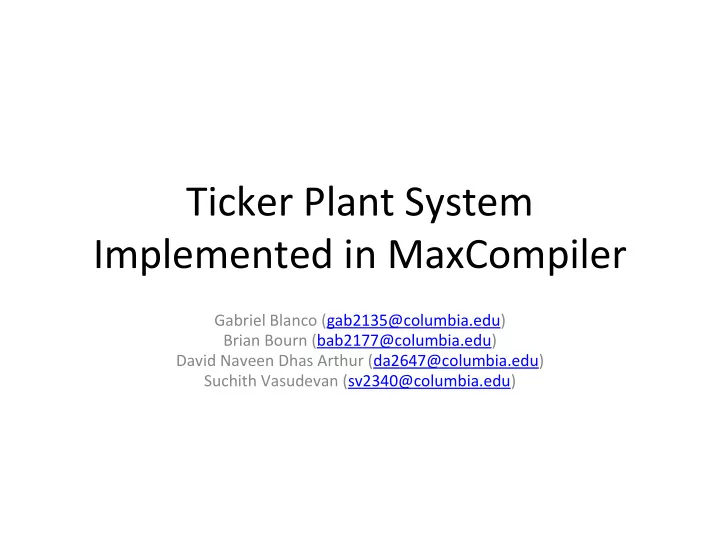

Ticker Plant System Implemented in MaxCompiler Gabriel Blanco (gab2135@columbia.edu) Brian Bourn (bab2177@columbia.edu) David Naveen Dhas Arthur (da2647@columbia.edu) Suchith Vasudevan (sv2340@columbia.edu)
Ticker Plant Receives data from the Exchange, calculates all possible implied values, then outputs them in a Machine Readable and sanitized format.
Implementation • Simulated market data is parsed CSV received through Ethernet (UDP) • Kernel computes implied market data from real market data and stores them in respective registers • Register data is transferred to order book through Ethernet (UDP)
Max Compiler ● Development Environment for writing optimized hardware code ● Compiles the .maxj (DFE engine and manager) to VHDL ● The MaxCompiler uses an extension of Java and a proprietary version of the Eclipse IDE ● Compile -> Quartus Compile Run -> Hardware Implementation
Software and Hardware Interface • Communication between the CPU and the FPGA done with a networking approach rather than shared memory. • UDP Streams sent through Ethernet
Hardware: Platform • Max4N FPGA platform • PCIE express bus • 24GB DDR3 offchip memory
Hardware: FPGA FPGA Altera Cyclone V 5CSXFC6D6F31C8ES Altera Stratix V 5SGXMABN2F45C2 Platform SoCKit Board Max4N Platform ALMS 41,910 359,200 Block Memory Bits 5,662,720 54,067,200 DSP Blocks 112 352 • Stratix V FPGA • Higher count of ALMs • On-Chip memory (M20k memory blocks)
Hardware: Networking • 2 QSFP Ports • 4x10 Gbps Ethernet • Avalon-ST 64-bit wide client interface • Operating Frequency: 156.25 MHz with 10-Gbps full-duplex throughput rate (Fmax = 203.6 Mhz)
Conclusion • MaxCompiler used a simulation engine that executed in a significantly shorter amount of time than a normal Quartus compile. • Documentation on the Maxeler IDE was sparse and heavily controlled by Maxeler, making it very hard to learn the language.
THANK$ $TE(pH)EN and DAVID! =D
Recommend
More recommend